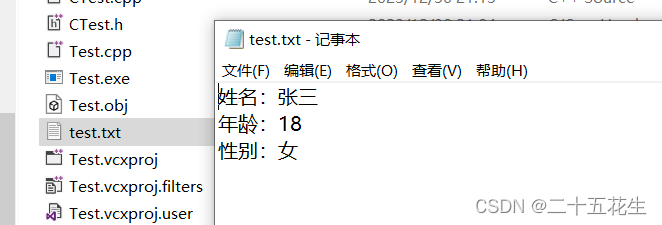【C++】文件操作
发布时间:2024年01月21日
程序运行时产生的数据都属于临时数据,程序一旦运行结束都会被释放,通过文件可以将数据持久化,C++中对文件操作需要包含文件
<fstream>
操作文件三大类:
1、ofstream:写操作
2、ifstream:读操作
3、fstream:读写操作
一、文本文件
文件以文本的ASCII码形式存储在计算机中
(一)写文件
步骤:
1、包含头文件cpp#include <fstream>
2、创建流对象ofstream ofs;
3、打开文件ofs.open("文件路径",打开方式);
4、写数据ofs<<"写入的数据";
5、关闭文件ofs.close();
| 打开方式 | 解释 |
|---|---|
| ios::in | 为读文件而打开文件 |
| ios::out | 为写文件而打开文件 |
| ios::ate | 初始位置:文件尾 |
| ios::app | 追加方式写文件 |
| ios::trunc | 如果文件存在先删除,再创建 |
| ios::binary | 二进制方式 |
文件打开方式可以配合使用,利用|操作符
例如用二进制写文件:ios::binary|ios::out
#include <iostream>
#include <string>
#include <fstream>
using namespace std;
void test() {
ofstream ofs;
ofs.open("test.txt", ios::out);
ofs << "姓名:张三" << endl;
ofs << "年龄:18" << endl;
ofs << "性别:女" << endl;
ofs.close();
}

读文件
步骤:
1、包含头文件cpp#include <fstream>
2、创建流对象ifstream ifs;
3、打开文件,判断是否打开成功ifs.open("文件路径",打开方式);
4、写数据:四种方式读取
5、关闭文件ifs.close();
void test1() {
ifstream ifs;
ifs.open("test.txt", ios::in);
if (!ifs.is_open()) {
cout << "文件打开失败" << endl;
return;
}
//读数据1
/*char buf[1024] = { 0 };
while (ifs >> buf) {
cout << buf << endl;
}*/
//读数据2
/*char buf[1024] = { 0 };
while (ifs.getline(buf,sizeof(buf))) {
cout << buf << endl;
}*/
//读数据3
/*string buf;
while (getline(ifs, buf)) {
cout << buf << endl;
}*/
//读数据4,EOF表示文件尾,不推荐
char c;
while ((c = ifs.get()) != EOF) {
cout << c;
}
ifs.close();
}
二、二进制文件
文件以文本的二进制形式存储在计算机中,用户一般不能直接读懂他们。
打开方式指定为ios::binary
(一)写文件
主要利用流对象调用成员函数write
函数原型:ostream& write(const char* buffer,int len);
参数解释:字符指针buffer指向内存中一段空间,len是读写的字节数。
#include <iostream>
#include <string>
//包含头文件
#include <fstream>
using namespace std;
class S {
public:
char name[64];
int age;
};
void test2() {
//创建流对象
ofstream ofs("s.txt", ios::out | ios::binary);
//打开文件
//ofs.open("s.txt", ios::out | ios::binary);
//写数据
S s1 = { "李四",20 };
ofs.write((const char*)&s1, sizeof(S));
//关闭
ofs.close();
}
会有乱码,但不影响读数据就行

(二)读文件
二进制方式读文件主要利用流对象调用成员函数read
函数原型:istream& read(char *buffer,int len);
参数解释:字符指针buffer指向内存中一段存储空间,len是读写的字节数。
void test() {
ifstream ifs;
ifs.open("s.txt", ios::in | ios::binary);
if (!ifs.is_open()) {
cout << "读取失败" << endl;
return;
}
S s1;
ifs.read((char*)&s1, sizeof(S));
cout << "姓名:" << s1.name <<"\t年龄:" << s1.age << endl;
ifs.close();
}
读取没问题

文章来源:https://blog.csdn.net/qq_50563459/article/details/135723638
本文来自互联网用户投稿,该文观点仅代表作者本人,不代表本站立场。本站仅提供信息存储空间服务,不拥有所有权,不承担相关法律责任。 如若内容造成侵权/违法违规/事实不符,请联系我的编程经验分享网邮箱:chenni525@qq.com进行投诉反馈,一经查实,立即删除!
本文来自互联网用户投稿,该文观点仅代表作者本人,不代表本站立场。本站仅提供信息存储空间服务,不拥有所有权,不承担相关法律责任。 如若内容造成侵权/违法违规/事实不符,请联系我的编程经验分享网邮箱:chenni525@qq.com进行投诉反馈,一经查实,立即删除!